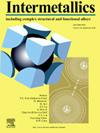Creep deformation behavior of an oxide dispersion strengthened modified iron aluminide alloy
IF 4.3
2区 材料科学
Q2 CHEMISTRY, PHYSICAL
引用次数: 0
Abstract
The present investigation highlights the creep deformation behavior of the yttria dispersion strengthened iron aluminide alloy in the temperature range of 600–700 °C at different stress levels. A relatively higher value of apparent Norton exponent (∼9 at 600 °C, 12.6 at 650 °C and 12.9 at 700 °C) of the investigated alloy has been rationalized with the incorporation of the concept of the threshold stress. After determining the threshold stress value of 103.6 MPa at 600 °C, 84.2 MPa at 650 °C and 74 MPa at 700 °C, the true Norton exponent value has been found as ∼3, which estimates the occurrence of glide-controlled creep mechanism in the investigated alloy. The TEM investigation of creep-tested sample substantiate the aforementioned governing creep deformation mechanism. The apparent activation energy for creep deformation has been found to be higher (∼613.7 kJ/mol) in the temperature range of 600–625 °C, and relatively lower (∼310.9 kJ/mol) in the temperature range of 650–700 °C. However, the true value of activation energy for creep deformation has been identified to be constant (∼44.2 kJ/mol) in the temperature range of 600–700 °C. Both the Modified Monkman-Grant relation and microscopic investigations of the investigated alloy have revealed a stable microstructural feature after creep deformation, which comprises nanometer-sized Y2O3 within the iron aluminide matrix. The Kernel Average Misorientation analyzed through EBSD analysis of the creep-tested samples have been correlated with the apparent Norton exponent and activation energy for creep deformation.
一种氧化物弥散强化改性铁铝合金的蠕变变形行为
本研究重点研究了钇弥散强化铁铝合金在600 ~ 700℃范围内不同应力水平下的蠕变变形行为。由于引入了阈值应力的概念,所研究合金的表观诺顿指数相对较高(600°C时为9,650°C时为12.6,700°C时为12.9)。在600℃时的阈值为103.6 MPa, 650℃时为84.2 MPa, 700℃时为74 MPa,确定了真实的诺顿指数值为~ 3,可以估计所研究合金中存在滑动控制蠕变机制。蠕变试样的透射电镜研究证实了上述蠕变控制机理。在600 ~ 625℃范围内,蠕变的表观活化能较高(~ 613.7 kJ/mol),而在650 ~ 700℃范围内,表观活化能相对较低(~ 310.9 kJ/mol)。然而,在600-700℃的温度范围内,蠕变的活化能的真实值是恒定的(~ 44.2 kJ/mol)。修正的Monkman-Grant关系式和显微研究表明,合金在蠕变变形后具有稳定的显微组织特征,即在铁铝化物基体中含有纳米尺寸的Y2O3。通过对蠕变试样的EBSD分析,分析了核平均取向偏差与表观诺顿指数和蠕变活化能之间的关系。
本文章由计算机程序翻译,如有差异,请以英文原文为准。
求助全文
约1分钟内获得全文
求助全文
来源期刊

Intermetallics
工程技术-材料科学:综合
CiteScore
7.80
自引率
9.10%
发文量
291
审稿时长
37 days
期刊介绍:
This journal is a platform for publishing innovative research and overviews for advancing our understanding of the structure, property, and functionality of complex metallic alloys, including intermetallics, metallic glasses, and high entropy alloys.
The journal reports the science and engineering of metallic materials in the following aspects:
Theories and experiments which address the relationship between property and structure in all length scales.
Physical modeling and numerical simulations which provide a comprehensive understanding of experimental observations.
Stimulated methodologies to characterize the structure and chemistry of materials that correlate the properties.
Technological applications resulting from the understanding of property-structure relationship in materials.
Novel and cutting-edge results warranting rapid communication.
The journal also publishes special issues on selected topics and overviews by invitation only.
 求助内容:
求助内容: 应助结果提醒方式:
应助结果提醒方式:


